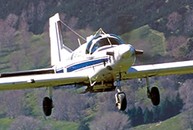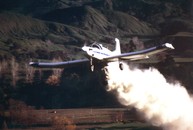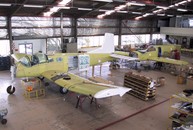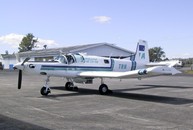Development History
 In the early 1980's, Pacific Aerospace Limited began working on the "Cresco", which is Latin for "I grow". The new aircraft featured a longer fuselage, a massive hopper, enlarged fin and rudder, revised wing with integral fuel tanks (wet wing) and a 600 hp, Lycoming LTP 101 turbine. The Cresco retained all the good features that had made the Fletcher a local legend. The aircraft was extremely rugged, easy to fly and maintain, and safe. It was an instant success, production began and it was Type Certified as the 08-600 Cresco.
In the early 1980's, Pacific Aerospace Limited began working on the "Cresco", which is Latin for "I grow". The new aircraft featured a longer fuselage, a massive hopper, enlarged fin and rudder, revised wing with integral fuel tanks (wet wing) and a 600 hp, Lycoming LTP 101 turbine. The Cresco retained all the good features that had made the Fletcher a local legend. The aircraft was extremely rugged, easy to fly and maintain, and safe. It was an instant success, production began and it was Type Certified as the 08-600 Cresco.
Although appearing very similar to the FU 24 Fletcher at first glance, the Cresco was actually a much bigger machine and improved in many ways.
1992 saw the introduction of the famous PT6-34AG turbine engine of 750 hp. Pratt and Whitney of Canada specifically designed this engine model for the agricultural aircraft market. It is considered by some to be perhaps one of the finest engines Pratt and Whitney manufactures. Its reliability, specific fuel consumption, durability, ease of maintenance, and cost of overhaul has helped earn the PT6-34AG its great reputation.

The Cresco also found use as a jump platform; special steps, door and grab rails were factory installed.
Development

This was an historic moment as it represented the first flight in the world of an aircraft designed from the outset as a turbine powered agricultural aircraft.
Configured as a dual control aircraft with a massive (for the time) 62.5 cu. ft. hopper it differed from future examples by having a full flying tail-plane (much like the FU-24) and no dorsal fin.
After a bright start to the certification process trouble stuck on the 10th December 1979 when, after difficulties during a test flight, the pilot elected to parachute to safety and consequently ZK-LTP was completely destroyed as it impacted the ground.
It was June 1980 before the second prototype ZK-LTQ s/n 002 took to the air for the first time and the certification process continued. Significantly ZK-LTQ unlike s/n 001, sported a new fixed tail-plane and a dorsal fin.
 By January 1981 the certification process was complete and production had commenced with s/n 003 ZK-LTR first flying on the 19th January 1981.
By January 1981 the certification process was complete and production had commenced with s/n 003 ZK-LTR first flying on the 19th January 1981.
Production had no sooner commenced when it was slowed considerably over the next decade due to a downturn in the farming sector. Only six further examples were produced between 1982 and 1992.
S/n 004 ZK- JAD the first 700 hp and single control variant was produced in January 1983 followed by s/n 005 ZK-LTS in September 1987. There was some relief in 1990 when three examples were produced for the Department of Plant Protection in Bangladesh. Next off the line was s/n 009 the last LTP101 powered variant (ironically like the prototype also ZK-LTP) which first flew in October 1992.
Then also in 1992 a significant event happened. The customer for s/n 010 requested replacement of the Lycoming LTP101 Engine with a Pratt & Whitney Canada PT6A-34AG engine of 750 shp. First flown in November 1992 the modification was an outstanding success and the PWC powered Cresco was now the standard aircraft that PAC still produces today and is commonly known as the Cresco 750.
When PAL changed ownership in late 1995 the first continuous Cresco 750 production commenced with s/n 012 ZK-TMO first flying on the 15th February 1996, and by the time the year was out four aircraft had been completed. A further five examples were completed in 1997 including several milestone aircraft:
S/n 019 the first aircraft with the "big" hopper mouth and gatebox, s/n 020 the first aircraft with the new extruded spar caps and s/n 021 the first utility version produced.
The next significant milestone was the production of the first utility parachuting variant s/n 024 in September 1999, which no doubt contributed somewhat to the subsequent development of the new P-750 XSTOL.
Production continued through the early 2000s and in 2002, the highest production year to-date, seven examples were produced cumulating in s/n 036 ZK-TTS.
Of the last 10 airframes produced five have been agricultural variants and five utility parachuting variants.
 Production totals now stand at 38 Aircraft with s/n 039 the latest off the production line. Of these 38 aircraft 27 have been produced over the last 7.5 years of current PAL ownership.
Production totals now stand at 38 Aircraft with s/n 039 the latest off the production line. Of these 38 aircraft 27 have been produced over the last 7.5 years of current PAL ownership.
In addition to this during the same period PAL has upgraded four of the early Lycoming LTP101 powered aircraft to PWC PT6A-34AG 750 shp status.
This unique and special aircraft is no longer in production.
